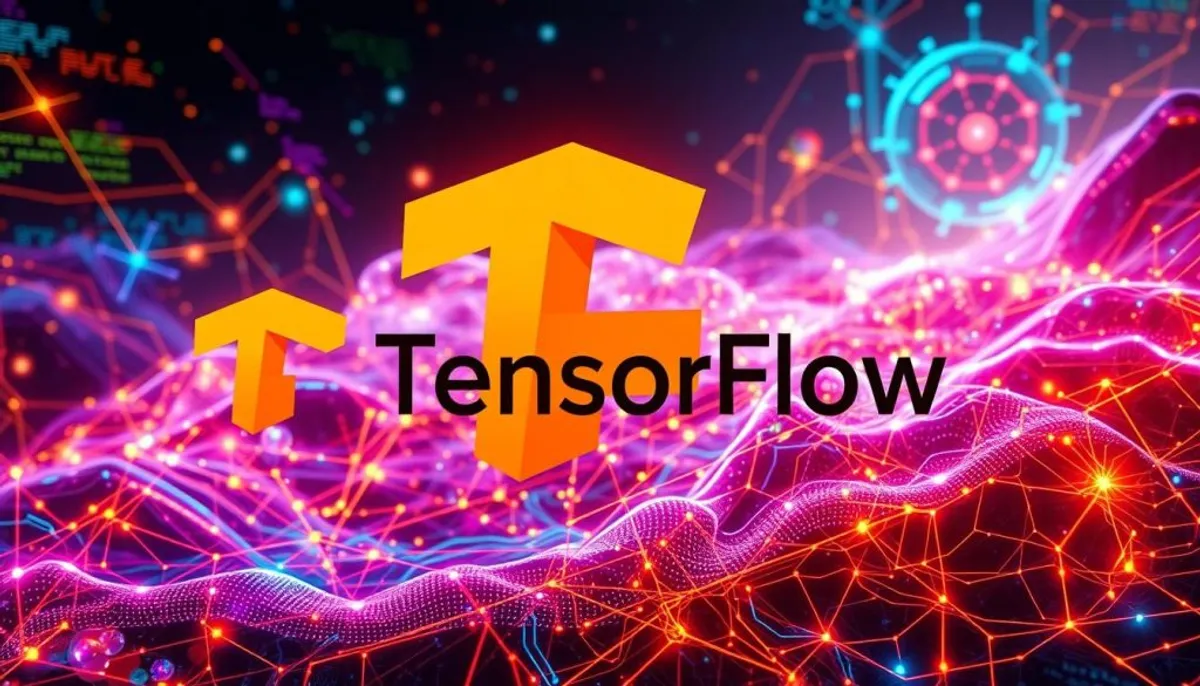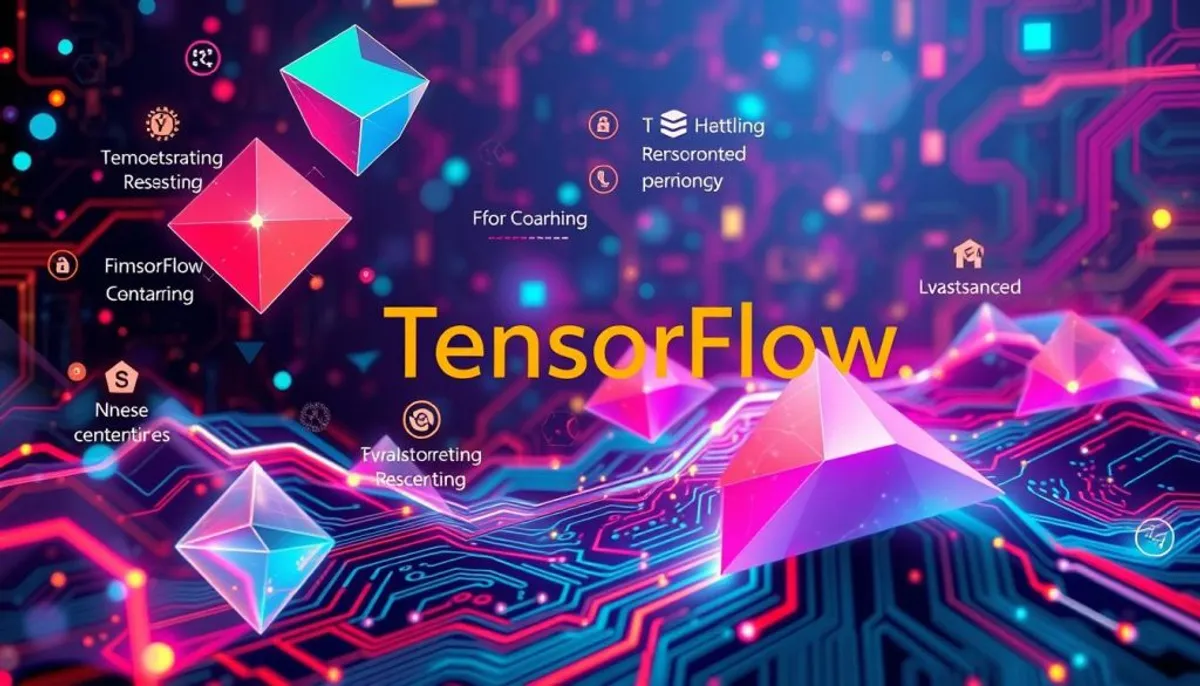In the fast-changing world of artificial intelligence and data science, TensorFlow stands out. It was created by Google’s Brain team. This free and open-source library focuses on numerical computation with data-flow graphs. Since its launch in 2015, TensorFlow has become a top choice for machine learning, deep learning, and predictive modeling.
Data scientists, researchers, and developers love TensorFlow for its flexibility and ability to handle big tasks. It’s used in many areas, like computer vision, natural language processing, speech recognition, and medical diagnostics. TensorFlow makes it easy to build and use complex machine learning models. This makes it key for finding data-driven insights and new ideas.

Key Takeaways
- TensorFlow is a powerful open-source machine learning framework developed by Google’s Brain team.
- It specializes in numerical computation using data-flow graphs, enabling efficient and scalable implementation of complex machine learning models.
- TensorFlow supports a wide range of applications, including computer vision, natural language processing, speech recognition, and more.
- The framework’s flexibility and high-level APIs make it accessible to both novice and experienced data scientists, accelerating the development and deployment of machine learning solutions.
- TensorFlow’s continuous evolution and the strong community support ensure ongoing advancements and new capabilities for the platform.
Introduction to TensorFlow
TensorFlow is a strong open-source machine learning framework made by the Google Brain team. It started for Google’s use but was made public in 2015. Since then, it has become a top choice for many machine learning tasks.
What is TensorFlow?
TensorFlow helps developers create and use deep learning and machine learning models. These models can be used for many things, like recognizing images or understanding language. It’s easy to use, thanks to its flexible design and simple APIs.
History and Evolution of TensorFlow
The story of TensorFlow began with DistBelief, an early version, in the Google Brain team. In 2015, Google launched TensorFlow 1.0, which included important features like Eager Execution and TensorFlow Lite. The 2019 release of TensorFlow 2.0 made it even better, improving performance and making it easier to use.
Key Features of TensorFlow
TensorFlow is a top choice for developers and researchers in AI. It’s known for its flexibility and scalability. These features let users build and run models on different platforms, like CPUs, GPUs, and even mobile devices.
Flexibility and Scalability
TensorFlow’s design makes it easy to adapt models to various hardware. This means you can run your models on anything from a powerful server to a small mobile device. The framework also grows with your projects, handling more complexity without losing performance.
High-Level APIs and Eager Execution
TensorFlow simplifies building and training neural networks with high-level APIs like Keras. These APIs make the process easier, letting developers focus on the important parts of their projects. TensorFlow also has an eager execution mode for quick operation checks, which helps with debugging and testing.
With its strong community and many tools, TensorFlow is widely used in the machine learning field. It’s great for both small and big projects. TensorFlow’s flexibility, scalability, and easy-to-use APIs make it a top pick for machine learning tasks.
TensorFlow Libraries and Tools
TensorFlow has more than just its core framework. It has a bunch of libraries and tools that make it better and let developers create stronger machine learning solutions. TensorFlow Lite and TensorBoard are two big parts of this group.
TensorFlow Lite for Mobile and Edge Devices
TensorFlow Lite is a slim version of TensorFlow made for mobile and edge devices. It makes machine learning work well on these devices. This means developers can use tensorflow in their apps and edge computing projects without losing speed or facing device limits.
TensorBoard for Visualization and Monitoring
TensorBoard is another key tool from TensorFlow. It helps developers see and keep an eye on how their models are doing. With TensorBoard, you get real-time info on training, model design, and performance. It makes understanding and improving tensorflow-based apps easier with its easy-to-use dashboard and visuals.
| TensorFlow Lite | TensorBoard |
|---|---|
| Optimized for mobile and edge devices | Visualization and monitoring suite |
| Enables efficient on-device inference | Provides real-time insights into training and model performance |
| Facilitates integration of ML models into mobile apps and edge computing | Simplifies the analysis and optimization of TensorFlow-based applications |

These libraries and tools make making, putting out, and watching machine learning solutions easier. They help developers make tensorflow-based apps for many uses. This includes mobile and edge devices and advanced visualization and monitoring features.
Deep Learning with TensorFlow
TensorFlow is a top machine learning framework for deep learning. It’s great for building and training complex neural networks. This lets developers work on tough tasks. TensorFlow supports deep learning techniques like Convolutional Neural Networks (CNNs) and Recurrent Neural Networks (RNNs) with Long Short-Term Memory (LSTMs).
Convolutional Neural Networks (CNNs)
CNNs are great for computer vision tasks like image classification and object detection. They use convolutional layers to learn spatial features from images. This makes them perfect for facial recognition, medical image analysis, and helping self-driving cars see the road.
Recurrent Neural Networks (RNNs) and LSTMs
TensorFlow also supports RNNs and LSTMs for tasks with sequences, like natural language processing and forecasting. These models are good at understanding context in data. They’re used in text generation, machine translation, and speech recognition.
TensorFlow’s deep learning features make it a top pick for many applications across industries. Its flexibility and scalability are key reasons why it’s so popular.
Traditional Machine Learning with TensorFlow
TensorFlow is known for its deep learning skills but also supports traditional machine learning. It lets developers work with models for tasks like linear regression, logistic regression, decision trees, and random forests.
This makes TensorFlow a versatile tool for many machine learning tasks. It can handle simple predictive models or complex deep neural networks. Data scientists and engineers can use TensorFlow’s tools to create strong and flexible machine learning solutions.
Linear Regression and Logistic Regression in TensorFlow
TensorFlow has easy-to-use APIs for linear regression and logistic regression. These methods are great for predicting continuous values or classifying binary outcomes.
Decision Trees and Random Forests with TensorFlow
Decision trees and random forests are key in tree-based machine learning. They work well for classification, regression, and finding important features. These models are useful in many applications.
By using TensorFlow’s strong machine learning features with these algorithms, data experts can make models that meet various business needs and problems.
tensorflow
TensorFlow is a top choice for deep learning, but it does more than just machine learning. It excels in transfer learning and reinforcement learning.
Revolutionizing Machine Learning with TensorFlow Hub
Building strong machine learning models takes a lot of time. TensorFlow Hub changes that. It’s a library with pre-trained tensorflow models and parts. Developers can add these to their projects easily.
This makes transfer learning faster and saves time and money. Teams can now quickly make and use powerful machine learning apps.
Reinforcement Learning Unleashed in TensorFlow
TensorFlow also supports reinforcement learning. Developers can use its tools to train smart agents in fake worlds. These agents learn by trying different actions and seeing the results.
This method is great for many things like making decisions on its own, game AI, and more. It opens new doors for many applications.
Using TensorFlow’s full power, including transfer learning and reinforcement learning, developers can do more in machine learning. These features make TensorFlow a top choice for many machine learning tasks.
Applications of TensorFlow
TensorFlow is a powerful tool for machine learning. It’s used in many areas, from healthcare to social media and retail. It helps solve tough problems and bring new ideas to life.
Medical and Healthcare Applications
In healthcare, TensorFlow makes medical imaging analysis faster and more accurate. It helps doctors spot body parts in MRI scans better and diagnose eye diseases from OCT scans more accurately. These tools could change how doctors treat patients, leading to better health outcomes.
Social Media and Retail Applications
TensorFlow isn’t just for healthcare. It’s also big in social media and retail. In social media, it helps pick the most interesting tweets for users. In retail, it makes product recommendations more personal, so customers find things they like.
It also helps with augmented reality in cosmetics. This lets customers try makeup virtually before buying it. TensorFlow’s skills in computer vision and natural language processing make these experiences possible.
TensorFlow’s use in different fields shows its power and flexibility. As machine learning needs grow, TensorFlow will keep playing a big part in many areas, from healthcare to online shopping.
Getting Started with TensorFlow
Starting your machine learning journey with TensorFlow is thrilling. This powerful framework has lots of resources for developers at all levels. It’s easy to install and set up, and the documentation and learning materials help you jump right in.
Installation and Setup
Installing TensorFlow is simple, depending on your operating system. For Windows, macOS, and Linux, the official TensorFlow website has clear guides. After installing, you can explore the Python libraries and APIs. These tools provide a solid base for your machine learning projects.
Learning Resources and Documentation
- The TensorFlow documentation is full of helpful information, from tutorials for beginners to advanced topics.
- The official website has many learning resources, like code examples, video tutorials, and materials from the community.
- There are also online courses, books, and blog posts for those wanting to learn more about TensorFlow.
- Whether you’re into deep learning or traditional machine learning, TensorFlow has the tools and resources you need.
With easy installation, detailed documentation, and a strong community, starting with TensorFlow is easy. Jump in and start making the machine learning apps you’ve dreamed of!
Conclusion
TensorFlow is a top open-source framework in machine learning, made by Google’s creative engineers. It’s known for its flexible design, strong features, and wide range of tools. This makes TensorFlow a top pick for developers and researchers on many projects, like medical imaging and social media.
TensorFlow keeps getting better and is set to be key in AI and machine learning growth. Its wide use and effect across industries have made it a leader in machine learning.
If you’re into machine learning or just starting, TensorFlow opens up many chances to try new things and explore. As tech keeps moving forward, TensorFlow’s impact will be seen in many areas. It will help shape the future of AI and more.
RelatedRelated articles

